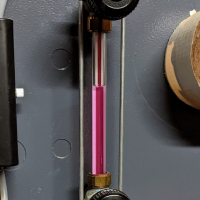Welcome! Here are the website rules, as well as some tips for using this forum.
Need to contact us? Visit https://heatinghelp.com/contact-us/.
Click here to Find a Contractor in your area.
Help with gas line size with reducing diameter pipes
Options
Zed
Member Posts: 3
in Gas Heating
I have a condo that has a gas hot water heater (part of a hydronic heating system) as the sole gas appliance in it. The water heater is a 50 gallon 65,000 BTU model that I'd like to replace. The gas line from the meter is 1" steel pipe for about 100' along the ceiling of the parking garage and then gets reduced at an elbow to 1/2" and rises straight up for about 30' to my condo unit where it feeds the water heater. There are no other branches on it. I'm trying to understand what my BTU capacity is given that the diameter reduces along the way or is it just calculated as if it was all 1/2"?
0
Comments
-
What pressure is the system? Is there an external regular at the water heater?
Is this natural gas or propane?Single pipe quasi-vapor system. Typical operating pressure 0.14 - 0.43 oz. EcoSteam ES-20 Advanced Control for Residential Steam boilers. Rectorseal Steamaster water treatment0 -
What is the gas pressure? Do you have a regulator at the water heater currently? You would calculate capacity as the pipe is sized- the 1" will have more volume/capacity at a given pressure than 1/2" at the same length and pressure. Capacity at the reducer would greatly exceed capacity at the water heater. So calculate capacity of 1" at 100 feet and then compare that with the capacity of 1/2" at 30 feet with your corresponding pressure. If 11" WC, you'd have ~197MBH available at your reducer but 96MBH at the appliance according to my chart. In theory you could run another 1/2" line 30ft elsewhere from a tee right next to the reducer and still have enough capacity from the 1" to serve both, if the total load is less than 197 MBH1
-
Capacity at the heater is about 73,000 btu. But if you have a lot of fittings you could be undersized. I am assuming this is natural gas and no other appliances are connected0
-
Yes, natural gas. Sorry, should have been more specific. This is standard PG&E residential service which I think is 7” WC? No other appliances connected other than the water heater.0
-
Northern California, correct?
The way the Uniform Plumbing Code (UPC) determines pipe size is by mapping out the system you want to install with all appliances and branches shown. You then figure the length of pipe from the meter to the most remote outlet and use that column to determine pipe size to all the appliances.
In your case, the run from the meter to the most remote outlet is 130'. Using Table 12-8 (0.5" pressure drop), a 1/2" line will supply 40,000 BTU's, a 3/4" line will supply 83,000 BTU's and a 1" line will supply 157,000 BTU's.
I'm using the 150' row as the closest to 130'.
Of course, considering the 100' of 1" pipe, the capacity will be greater than a 1/2" line from the meter to the appliance. But how much greater is the question.
Conservatively, I would say that you have 80,000 BTU's available. If the job is inspected, it will depend on the inspector.8.33 lbs./gal. x 60 min./hr. x 20°ΔT = 10,000 BTU's/hour
Two btu per sq ft for degree difference for a slab0 -
The way I look at this it is the 1/2" should have been 3/4" But using the branch sizing method (which really isn't right for only one appliance) it's ok as is in my opinion0
-
Thanks folks, super helpful. Yes, this is in San Francisco. Just trying to figure out what options might be available and whether something like an HTP Crossover Floor might be viable. As it's a condo, I have to pretty much stick with the existing gas service. It appears that some units in the building replaced the horizontal segment of the run in the garage with larger diameter pipes, presumably to increase capacity, but the 1/2" vertical segment that goes up through the units obviously has to be left as-is and was an unfortunate cheap move by the original builders. At least now, I can hopefully have a smarter conversation about this.0
-
I'd say no, it won't work. I believe (not sure) that this heater has a negative pressure gas valve which are notoriously finicky about gas supply pressures.
Just my opinion.8.33 lbs./gal. x 60 min./hr. x 20°ΔT = 10,000 BTU's/hour
Two btu per sq ft for degree difference for a slab0
Categories
- All Categories
- 85.2K THE MAIN WALL
- 3.1K A-C, Heat Pumps & Refrigeration
- 55 Biomass
- 424 Carbon Monoxide Awareness
- 73 Chimneys & Flues
- 1.9K Domestic Hot Water
- 5.2K Gas Heating
- 129 Geothermal
- 160 Indoor-Air Quality
- 3.3K Oil Heating
- 61 Pipe Deterioration
- 884 Plumbing
- 5.9K Radiant Heating
- 376 Solar
- 14.7K Strictly Steam
- 3.2K Thermostats and Controls
- 59 Water Quality
- 49 Industry Classes
- 89 Job Opportunities
- 28 Recall Announcements


